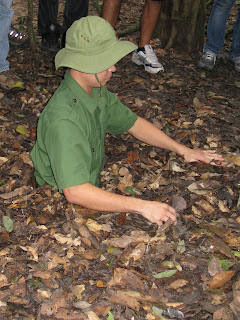Wildlife Rescue Center & Cu Chi Tunnels, 9/6
 The students spent the rest of the week in language and other classes. On Friday afternoon we had a briefing by the Counsel General of the U.S. Consulate. Very candid talk on the U.S. relationship with Vietnam, and issues that Vietnam must confront in its quest for a higher ranking among the countries of the world.
The students spent the rest of the week in language and other classes. On Friday afternoon we had a briefing by the Counsel General of the U.S. Consulate. Very candid talk on the U.S. relationship with Vietnam, and issues that Vietnam must confront in its quest for a higher ranking among the countries of the world.On Saturday, 9/6, our first stop was the Cu Chi Wildlife Rescue Station. It is operated by a group called Wildlife at Risk (WAR), which is dedicated to "Protecting the biodiversity of Vietnam by combating the illegal wildlife trade, raising environmental awareness, and promoting the conservation of endangered species an their habitats." They have been active for some time, but this is their first facility to rescue animals and reintroduce as many as possible back into the wild.

Pam found out that gibbons can reach further than you would think.

Here Matthew Wills, the Director of the center, explains about the Gibbons, and the workings of the center. Matt is an Australian, and WAR is a non-governmental organization (NGO), which says a lot about the official government stance on endangered species, and wildlife in general.

The Gibbons are interesting critters, but are very active and have a very loud, shrill call. Not something most people would tolerate for long in their home.
The sun bear shown will not be reintroduced into the wild, because they are hunted for the medicinal use of their liver bile. There are synthetic substitutes, and WAR is trying to promote their use.



Here Viet, our travel guide, explains the significance of the Cu Chi Tunnels. Viet has worked with the program for several years, and is an excellent guide. He runs tours for international groups, and has guided a number of celebrities, including Robert DiNero. If you are planning on visiting anywhere in Southeast Asia, he would be a good person to have plan your trip. He can be reached at viet@vietorienttours.com.


American troops couldn't find the tunnels because they were so well camouflaged. Here Viet explains about a hidden firing position, in the dirt pile behind him. They also used fake termite mounds as air
 holes.
holes.
In the next three pictures a reenactor shows how the VC would enter the tunnels through a trap
 door, then hide the entrance behind them. Several students also went down through this opening, and came up a few meters away.
door, then hide the entrance behind them. Several students also went down through this opening, and came up a few meters away.
We sent troops into the area to try to feret out the VC, but were unsuccessful, while taking casualties from disappearing snipers and small bands of guerrillas. We found a few tunnels, but never got below the first level. We then resorted to defoliation, napalm, bulldozers, and gas to try to route out the inhabitants. We sent soldiers (tunnel rats) and dogs into the tunnels, but the casualties were much too high for the advantage gained. Finally in 1969 we resorted to carpet bombing the area with B-52s. These had the most effect in destroying at least the first two levels, and killing many guerrillas (up to 50,000 VC and NVA soldiers, and sympathyzing civilians died in the tunnel areas during the conflict), but it was too late as the U.S. had already lost interest in the war. The VC also had alternative routes that they could take around the Iron Triangle.


Most students accepted his invitation, and descended into the second and third levels of the tunnels. At points they had to crawl on their hands and knees. They all came up about a hundred meters distant, dirty and hot, but otherwise none the worse for wear.


The main reason the VC were able to make a surprise attack on Saigon during the TET offensive of 1968 was that both men
 and materials had been infiltrated through the tunnels right into the city.
and materials had been infiltrated through the tunnels right into the city.This temple on the Cu Chi Tunnel site is dedicated to the 50,000 soldiers and civilians killed in the tunnels and the surrounding area during the conflict. You don't see any memorials dedicated to the soldiers from South Vietnam who were killed.
 Our next stop was lunch at a floating restaurant on the Saigon River. The tunnels actually connected with the river, but underwater so the exits could not be found from the river.
Our next stop was lunch at a floating restaurant on the Saigon River. The tunnels actually connected with the river, but underwater so the exits could not be found from the river.





0 Comments:
Post a Comment
Subscribe to Post Comments [Atom]
<< Home